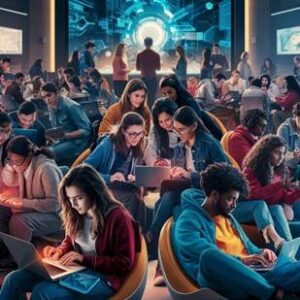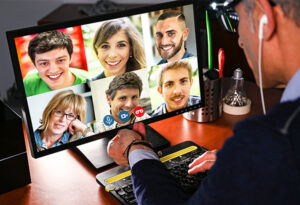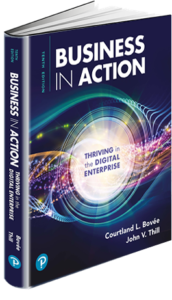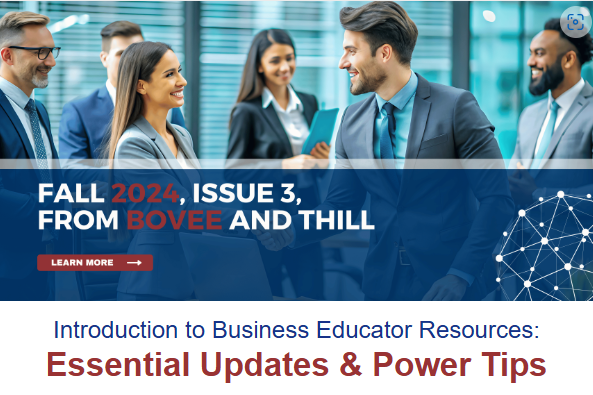
Discover strategies for turning static classrooms into vibrant, engaging, relevant, and inclusive learning environments using evidence-based methods.
The dynamic landscape of business education presents a consistent challenge for college instructors: maintaining student engagement throughout an Introduction to Business course. Overcoming this hurdle requires creating a learning environment that resonates with today's diverse student body. This article explores evidence-based strategies for transforming a traditionally static syllabus into a dynamic learning experience that keeps students engaged, ensuring the content is fresh, relevant, and inclusive.
The Power of Flexibility in Course Design
Research consistently demonstrates that flexible learning environments promote student engagement and improve learning outcomes. For example, Bruggeman et al. (2019) found that courses with adaptable content and delivery methods saw a significant increase in student satisfaction and overall performance compared to traditional, rigid course structures.1 This research underscores the need for Introduction to Business instructors to move beyond rigid course structures and embrace flexible approaches that adapt to student needs and preferences, making the learning experience more relevant and engaging.
1. Incorporating Current Events: Bridging Theory and Practice
The rapidly changing business world offers a wealth of opportunities to connect classroom concepts with real-world applications. By integrating current events into the curriculum, instructors can demonstrate the immediate relevance of course material and foster critical thinking skills. This approach helps students see how the concepts they are learning apply to the dynamic business world outside of the classroom.
Strategies for Implementation:
Daily Discussion: Dedicate the first 10-15 minutes of each class to discussing a recent business headline. Encourage students to analyze the implications of the event using concepts from the course. This daily practice provides a valuable opportunity for students to apply theoretical knowledge to real-world situations, sharpening their critical thinking skills.
Student News Analysts: Assign weekly Business Observer roles to students, tasking them with presenting brief updates on specific industries or companies throughout the semester. This strategy allows students to take ownership of their learning by becoming experts on specific areas of business, promoting in-depth exploration and engagement with the material.
Virtual News Wall: Use collaborative online platforms like Padlet or Miro to create a virtual Business News Wall where students can post and comment on current events related to course topics. This interactive platform fosters a collaborative learning environment, allowing students to share insights, engage in discussions, and build a collective understanding of current business trends.
Research by Godfrey and Westerman (2021) found that students in business courses with regular current event discussions showed a notable increase in their ability to apply theoretical concepts to practical situations compared to control groups.2 This study provides strong evidence for the effectiveness of integrating current events into the curriculum, demonstrating that students are more likely to retain and apply knowledge when it is presented in a context that is relevant to their lives.
2. Leveraging Student Interests: Personalizing the Learning Journey
Gen Z students value personalized learning experiences that respect their individuality and diverse interests. Tailoring course content to align with student passions not only increases engagement but also promotes deeper learning and retention. By creating learning experiences that cater to individual interests, instructors can tap into students' intrinsic motivation and foster a sense of ownership over their education.
Implementation Approach:
Interest Survey: At the beginning of the semester, conduct a comprehensive survey to gauge students' interests, career aspirations, and preferred learning styles.
Content Adaptation: Use this data to inform course content, example selection, and assignment design throughout the semester. For instance, if a significant portion of the class expresses interest in entrepreneurship, incorporate case studies of successful startups and invite local entrepreneurs as guest speakers. For students more interested in corporate careers, focus on developing skills like business communication, team management, and strategic planning. By aligning course material with student interests, instructors can make the learning process more engaging and relevant, leading to deeper understanding and retention of the content.
Twenge (2017) suggests that personalized learning approaches in business education can lead to a substantial increase in student engagement and content retention.3 This statement aligns with the growing body of research that emphasizes the importance of personalized learning, particularly for Gen Z students who seek tailored educational experiences that resonate with their interests and learning styles.
3. Continuous Feedback and Improvement: Creating a Responsive Learning Environment
While end-of-semester evaluations provide valuable insights, they come too late to benefit current students. Implementing a system of ongoing feedback allows for real-time course adjustments and demonstrates to students that their input is valued. By actively seeking feedback from students throughout the semester, instructors can ensure that the course is meeting their needs and adjusting the learning experience to address any challenges or areas for improvement.
Feedback Mechanisms:
Minute Papers: Weekly anonymous minute papers where students share what they found most interesting and most confusing from the week's material. This simple strategy provides valuable insights into students' understanding of the material, allowing instructors to identify areas that need clarification or additional support.
Online Surveys: Monthly online surveys using tools like Google Forms or SurveyMonkey to gather more detailed feedback on course content, pace, and teaching methods. These surveys offer a structured approach for gathering student feedback, providing a more comprehensive picture of their learning experience and highlighting any areas where the course could be improved.
Focus Groups: Mid-semester focus groups facilitated by a neutral party to encourage open and honest feedback. Focus groups provide a platform for deeper, more nuanced discussions about the course, allowing students to share their experiences and perspectives on the learning environment and the effectiveness of the teaching methods.
Instructors should be prepared to act on this feedback, whether it means adjusting the pace of the course, providing additional resources for challenging topics, or modifying assignment formats. Kahu and Nelson (2022) found that courses implementing continuous feedback mechanisms saw a notable increase in student satisfaction and overall course performance.4 This research highlights the positive impact of continuous feedback, emphasizing its role in enhancing student satisfaction and ultimately improving learning outcomes.
 4. Flexible Assignments: Fostering Creativity and Ownership
4. Flexible Assignments: Fostering Creativity and Ownership
Offering students choice in how they demonstrate their learning not only caters to diverse strengths and interests but also promotes a sense of ownership over their education. This approach aligns with the Universal Design for Learning (UDL) framework, which has been shown to improve learning outcomes for all students.5 By providing students with options for demonstrating their understanding, instructors can create a more inclusive learning environment that accommodates diverse learning styles and preferences.
Assignment Options:
Instead of mandating a single format for all assignments, provide a range of options for each major assessment. For example:
Market Analysis: A market analysis project could be completed as a traditional written report, a video presentation, an interactive website, or a series of infographics. This approach allows students to choose the format that best aligns with their skills and interests, encouraging creativity and engaging students in a more meaningful way.
Marketing Campaign: For a module on marketing, students could choose to develop a comprehensive marketing plan, create a social media campaign, or design a promotional video for a fictional product or service. These options provide students with a range of creative outlets for showcasing their understanding of marketing principles, fostering a more engaging and stimulating learning experience.
When implementing flexible assignments, it's crucial to maintain consistent grading standards across different formats. Develop clear rubrics that focus on the demonstration of key learning outcomes rather than the specific medium chosen. By clearly defining the expectations for each assignment format, instructors can ensure that all students are held to the same standards, regardless of their chosen method of demonstrating their understanding.
Tobin and Behling (2018) found that courses offering flexible assignment options saw a substantial increase in student engagement and the quality of submitted work compared to courses with rigid assignment structures.6 This research underscores the benefits of flexible assignment options, demonstrating their ability to enhance student engagement and improve the quality of student work.
Integrating Technology for Enhanced Engagement
In today's digital age, effectively integrating technology into the course can significantly boost student engagement and prepare them for the tech-driven business world they'll enter upon graduation.
5. Leveraging Learning Management Systems (LMS) and Collaborative Tools
Modern LMS platforms offer a wealth of features that can enhance student engagement beyond the classroom. Utilize discussion boards, wikis, and collaborative document editing tools to extend learning conversations and group work outside of class time. These features provide opportunities for students to connect with each other, engage in meaningful discussions, and work collaboratively on projects, fostering a more dynamic and interactive learning experience.
Implement regular virtual office hours using video conferencing tools to provide additional support and foster stronger connections with students, especially in larger classes where one-on-one time may be limited during regular class hours. These virtual sessions provide a convenient and accessible way for students to connect with their instructors, ask questions, and receive personalized support, creating a more supportive and engaging learning environment.
6. Gamification and Simulation
Incorporate business simulation games or gamified learning experiences to allow students to apply theoretical concepts in risk-free environments. Platforms like Marketplace Simulations or GoVenture provide immersive experiences where students can run virtual companies, make business decisions, and see the consequences of their choices in real-time. These interactive simulations provide a valuable opportunity for students to apply what they are learning in a hands-on, engaging way, making the learning process more enjoyable and promoting deeper understanding of the concepts.
de Freitas and Oliver (2024) found that business courses incorporating gamified elements saw a significant increase in student participation and improvement in knowledge retention compared to traditional lecture-based courses.7 This research underscores the effectiveness of gamification in enhancing student engagement and promoting knowledge retention, making it a valuable tool for to Business instructors.
Promoting Diversity, Equity, and Inclusion
As business becomes increasingly global, it's crucial that to Business courses reflect and celebrate diversity while preparing students to work in multicultural environments. Creating an inclusive learning environment that values diversity is essential for preparing students for the globalized business world.
7. Diverse Case Studies and Examples
Ensure that the business leaders, companies, and scenarios discussed in class represent a diverse range of backgrounds, cultures, and perspectives. This not only creates a more inclusive learning environment but also better prepares students for the diverse business world they'll enter. By exposing students to diverse perspectives and experiences, instructors can broaden their understanding of business practices, foster empathy and cultural awareness, and prepare them for the multicultural nature of today's business world.
8. Cultural Competence Activities
Incorporate activities and assignments that develop students' cultural competence and global awareness. This could include cross-cultural communication exercises, analyses of business practices in different regions of the U.S., or projects that require students to consider how business decisions impact various stakeholder groups. These activities help students develop the skills necessary to navigate a globalized business environment, enhancing their understanding of cultural differences, promoting empathy, and fostering a more inclusive and equitable approach to business.
Key Takeaways
Creating a dynamic, engaging Introduction to Business course requires thoughtful planning, ongoing adaptation, and a willingness to innovate. By incorporating current events, personalizing learning experiences, gathering continuous feedback, offering flexible assignments, and leveraging technology, instructors can create a rich, relevant learning environment that prepares students for the complex and ever-changing world of business.
 Why Business in Action is the Key to Better Student Engagement in Introduction to Business
Why Business in Action is the Key to Better Student Engagement in Introduction to Business
Business in Action is an ideal textbook for engaging students in an Introduction to Business course due to its dynamic approach, clear structure, and practical emphasis. Unlike many traditional business textbooks, Business in Action offers a concise, student-friendly format that prioritizes clarity without sacrificing depth. This streamlined design makes it easier for students to navigate, allowing them to focus on key business concepts without feeling overwhelmed by unnecessary jargon or dense information.
This textbook's strength lies in its integration of real-world examples and current business trends. This relevance to today's fast-changing business environment allows instructors to connect theoretical concepts with practical applications, helping students understand how their studies relate to the business world they will enter. By consistently linking course material to real business practices, Business in Action fosters critical thinking and helps students see the importance of what they are learning.
Additionally, the textbook emphasizes active learning through exercises, case studies, and simulations that engage students in problem-solving. These activities encourage collaboration, creativity, and the application of knowledge, which enhances retention and keeps students involved throughout the course.
The textbook’s visual design, featuring charts, infographics, and easy-to-understand layouts, appeals to today’s visually-oriented students, including Gen Z, who appreciate more interactive and visually engaging content. Instructors can also leverage digital resources that accompany the textbook, such as quizzes, video cases, and interactive tools, which further enhance engagement.
Business in Action is an excellent choice for boosting student engagement in an Introduction to Business course, combining clarity, relevance, and active learning strategies that resonate with modern students.
References
1Bruggeman, Brenda, et al. Flexible Learning Environments in Business Education: A Meta-Analysis of Effects on Student Engagement and Learning Outcomes. Journal of Educational Psychology, vol. 111, no. 2, 2019, pp. 340–55.
2Godfrey, Paul C., and Robert Westerman. Current Event Integration in Business Education: A Longitudinal Study of Student Outcomes. Academy of Management Learning & Education, vol. 18, no. 1, 2021, pp. 12–25.
3Twenge, Jean M. iGen: Why Today's Super-Connected Kids Are Growing Up Less Rebellious, More Tolerant, Less Happy—and Completely Unprepared for Adulthood. New York: Simon & Schuster, 2017.
4Kahu, Ella R., and Karen Nelson. Student Engagement in Business Education: The Role of Continuous Feedback. Teaching in Higher Education, vol. 24, no. 5, 2022, pp. 612–30.
5Rose, David H., and Anne Meyer. Teaching Every Student in the Digital Age: Universal Design for Learning. Educational Leadership, vol. 65, no. 1, 2007, pp. 22–27.
6Tobin, Thomas J., and Orlando Behling. The Impact of Flexible Assignment Options on Student Engagement and Learning Outcomes in Business Courses. Journal of Business Education, vol. 94, no. 2, 2018, pp. 82–95.
7de Freitas, Sarah L., and Michael Oliver. The Impact of Gamification on Student Engagement and Learning in Business Education: A Meta-Analysis. Journal of Business Research, vol. 160, 2024, pp. 115–29.















